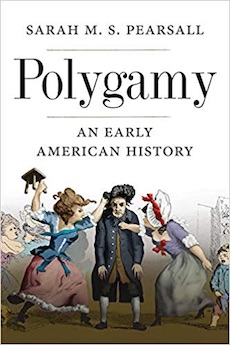By Louis J. Kern
In the beginning America was polygamous. First encounters: singly-mated Europeans faced Native Americans practicing traditional status-based polygyny. Sarah M.S. Pearsall provides the first in-depth discussion of the dynamics of multiple-wife families from the 17th to the mid-19th century. This largely unknown history offers a fresh perspective on marriage, family organization and power dynamics, sexuality and gender, and a deeper understanding of the interrelationships between the personal and the political.
Clashes between monogamy and polygamy, ostensibly about the legitimacy of marriage, sex, and men’s sexual privilege, provided a casus belli for more pervasive struggles over race, religion, resources, land, and broader cultural differences. As Pearsall observes, they open a window on “a dark history of America” that predicated sexual morality on religiously sanctioned unions between one man and one woman.
Plural wives of biblical patriarchs were ignored in favor of the more ascetic, misogynistic conception of St. Paul, grounded in the subjection of wives to husbands. Encountering deviance, Europeans considered its practitioners heathen to be either converted or eliminated. In New Spain, Franciscan missionaries, who enslaved Indians, experienced two bloody native uprisings—the Guale Rebellion (1597) and the Pueblo Revolt (1680), both sparked by conflicts over unsanctioned multiple marriages. New England Puritans, surprisingly, debated biblical polygamy and more modern examples—Anabaptist John of Leiden’s theocratic state (Münster) and the errant beliefs of the Familists (Family of Love)—but they adamantly opposed native polygamy. Matacom and Weetamoo’s War (1675-1676) sparked by indigenous resistance to colonial expansion, also implicated polygamy since Metacom had multiple wives and Weetamoo was a polygamous wife. Narragansett captive Mary Rowlandson typically considered their “customs and manners . . . very brutish and barbarous—they take many wives (Narrative of Captivity and Restoration, 1682).
As a traditional social form, polygamy evolved over time, serving indigenous peoples as a foundation for status, a symbol of resistance to colonial intrusions, religious self-righteousness and pressures for conversion, European engrossment of land that destabilized native communities, and the imposition of disruptive racially-based folkways.
By the 18th century opposition to polygamy shifted from combatting religious deviance to seeking to pursue enlightenment and rational social organization among native peoples whose immorality resided in their barbarism. The basic trope became the Turkish harem, presupposing female slavery to male lust. As affection and happiness came to be considered sine qua non of marriage, romantic ideas of one love came to dominate. These ideas meshed seamlessly with the legitimacy of slavery, a means of containing and controlling savage peoples of color. This construction of polygamy prevailed when the issue of white polygamy was raised by Mormonism.
Pearsall argues for a more nuanced understanding of polygamy and greater humility in seeing the ways in which monogamy oppressed women in this period—lack of protections from domestic abuse, restrictions on the right to divorce, legal couverture, deprivation of property, and lack of contraception to regulate pregnancies. Her discussion of Belinda Hilton’s A Defense of Polygamy by a Lady (1854) reveals the advantages—female companionship, shared childrearing, and reduced childbearing—of what opponents considered a “relic of barbarism.”
Mormons abolished polygamy in 1890 but it still exists among sectarians—the Apostolic Brethren and the Fundamental Church of the LDS (estimated practitioners in the U.S. of 50,000 to 100,000). The popularity of Big Love (HBO, 2006-2011) and reality show Sister Wives (TLC, 2010-2020) suggest broad shifts in popular attitudes towards polygamy. Despite the virulence of Christian opposition, a current worldwide ethnographic survey of 1231 societies found 1041 (85%) to be polygamous and 186 (15%) monogamous, the latter overwhelmingly Eurocentric. In the great marriage battle it would seem that plurality won out.
Louis J. Kern (ΦBK, Clark University) is professor emeritus of history at Hofstra University. Hofstra University is home to the Omega of New York chapter of Phi Beta Kappa.




